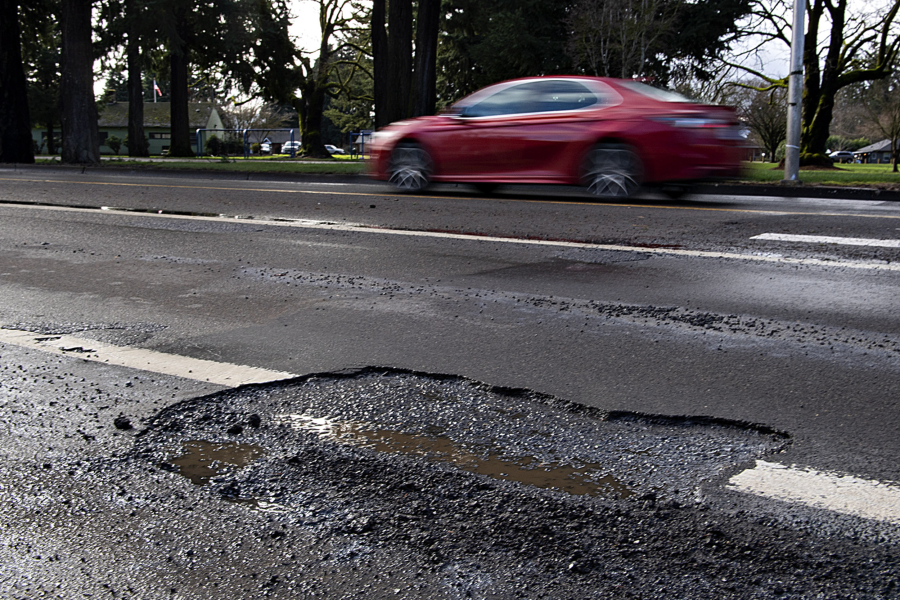If you’ve noticed yourself swerving to avoid potholes, you’re not alone; roads in Clark County are littered with potholes after a week of snow and ice.
Potholes form when ice, snow or rain seeps into asphalt pavement through cracks. The moisture beneath the surface expands when temperatures drop. When it drains, a gap forms underneath the pavement, which crumbles into a pothole when a vehicle drives over it.
Because of the cold and wet conditions, local and state maintenance crews are repairing potholes with temporary patches. They will apply more permanent fixes in the summer. Temporary patches require removing loose debris and using cold-mix asphalt to smooth out the roadway. A patch can last for a couple of weeks up to a few months.
With the increased roadwork, officials urge drivers to pay attention, particularly after a Sunday night crash hospitalized six Washington State Department of Transportation workers who were attempting to fix potholes on Interstate 5 northbound, just past where it merges with Interstate 205.
WSDOT received 36 pothole complaints in Clark and Cowlitz counties between Sunday and Tuesday. Last year, WSDOT maintenance crews patched approximately 360 potholes in the two counties. The agency did not immediately have data available for the number of potholes patched year to date versus the same time frame last year, “because our crews were full court press on weather response across the region beginning as early as Jan. 6 and 7,” said Kelly Hanahan, WSDOT assistant communications manager.
“Virtually all sheds were addressing snow, ice and freezing rain 24/7. Then, crews shift from weather response directly into pothole repair,” she said in an email.
One hurdle, Hanahan said, is that the agency’s maintenance and preservation funding is at 40 percent of current needs.
“A lot of our asphalt and concrete pavement surfaces on roadways like I-5 and I-205 in Southwest Washington are at the end of their serviceable life and already in need of replacement,” she said. “Following freezing temperatures potholes pop up much quicker and are more severe.”
County roads with the most potholes typically are those with high traffic volumes and older pavement, according to Kaley McLachlan-Burton, a Public Works spokeswoman.
The county has received about 20 customer service requests for pothole repairs since Jan. 19, McLachlan-Burton said. But the requests largely describe sections of roadway and not individual potholes, she said.
Like WSDOT, county officials apply a short-term fix before making larger repairs during the warm-weather months. Potholes reported by residents to the county’s Report a Concern form are prioritized, in addition to severe potholes on high-volume roads.
City roads, like state and county roads, are not immune to potholes. As of Tuesday morning, the city received 10 pothole complaints in the wake of the storms, according to Ryan Lopossa, streets and transportation manager for the city of Vancouver. In 2023, city staff repaired more than 4,300 potholes.
Neither the city nor county had data immediately available for the number of potholes patched year to date versus the same time frame last year.
“Potholes typically show up en masse immediately following a severe weather freeze event. Our 2023 event was in February, so we weren’t doing a lot of pothole repairs in January of last year as compared to what we’re doing this year,” Lopossa said of the city of Vancouver.
After a pothole is reported, a city crew inspects the damage and usually makes repairs on the spot. City crews use torches to dry the area and asphalt patch mix to fill in the pothole.
City officials work to respond to pothole complaints within 48 hours. Potholes on high-traffic streets are prioritized, Lopossa said.
Some residents took to social media earlier this week to warn other drivers about potholes. Several people complained of blown tires and wondered if any agencies offer monetary assistance or reimbursement for repairs.
Lopossa said that if someone suspects their vehicle was damaged due to a pothole on a city street, they can contact the city of Vancouver’s Risk Management Department to discuss filing a claim. People with property damage claims against the county can go to https://clark.wa.gov/human-resources/risk-management for information.
An employee at Les Schwab Tire Center on Northeast Andresen Road said he has not seen an influx in flat-tire repairs since the winter storms.




